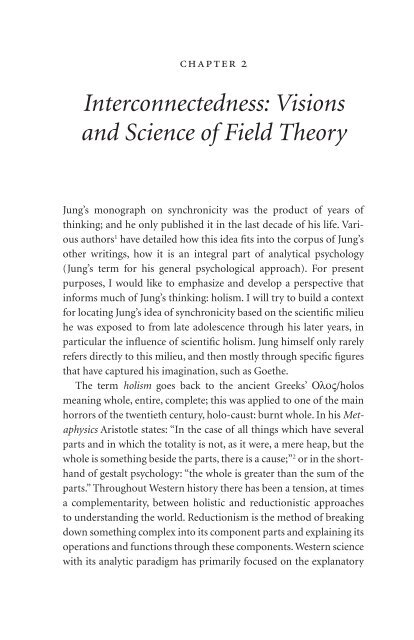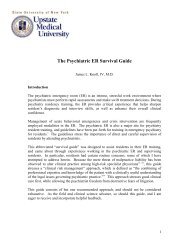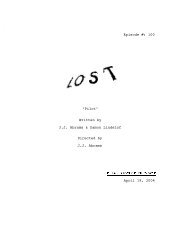Synchronicity Cambray
Synchronicity Cambray
Synchronicity Cambray
Create successful ePaper yourself
Turn your PDF publications into a flip-book with our unique Google optimized e-Paper software.
chapter 2<br />
Interconnectedness: Visions<br />
and Science of Field Theory<br />
Jung’s monograph on synchronicity was the product of years of<br />
thinking; and he only published it in the last decade of his life. Various<br />
authors 1 have detailed how this idea fits into the corpus of Jung’s<br />
other writings, how it is an integral part of analytical psychology<br />
(Jung’s term for his general psychological approach). For present<br />
purposes, I would like to emphasize and develop a perspective that<br />
informs much of Jung’s thinking: holism. I will try to build a context<br />
for locating Jung’s idea of synchronicity based on the scientific milieu<br />
he was exposed to from late adolescence through his later years, in<br />
particular the influence of scientific holism. Jung himself only rarely<br />
refers directly to this milieu, and then mostly through specific figures<br />
that have captured his imagination, such as Goethe.<br />
The term holism goes back to the ancient Greeks’ OloV/holos<br />
meaning whole, entire, complete; this was applied to one of the main<br />
horrors of the twentieth century, holo-caust: burnt whole. In his Metaphysics<br />
Aristotle states: “In the case of all things which have several<br />
parts and in which the totality is not, as it were, a mere heap, but the<br />
whole is something beside the parts, there is a cause;” 2 or in the shorthand<br />
of gestalt psychology: “the whole is greater than the sum of the<br />
parts.” Throughout Western history there has been a tension, at times<br />
a complementarity, between holistic and reductionistic approaches<br />
to understanding the world. Reductionism is the method of breaking<br />
down something complex into its component parts and explaining its<br />
operations and functions through these components. Western science<br />
with its analytic paradigm has primarily focused on the explanatory









